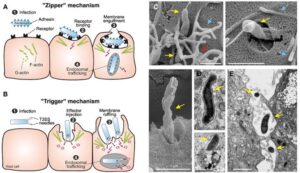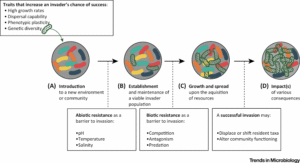Back to: MICROBIOLOGY 100 LEVEL
Welcome to class!
Hello, my brilliant friend! It’s so good to see you again. Today, we’re going to talk about something very important in understanding how microbes cause disease—Invasion Mechanisms. This simply means how harmful microorganisms, like bacteria or viruses, find their way deep into the body, avoid the body’s defence system, and begin to cause illness. By the end of this lesson, you’ll understand how they do it and why it’s so important in microbiology.
Invasion Mechanisms
What Are Invasion Mechanisms?
Invasion mechanisms are the different ways by which microorganisms enter the body, move through tissues, and escape the body’s defences in order to cause infection. It’s one thing for a microbe to land on your skin or be swallowed through food—it’s another thing for it to successfully move inside and start an infection. That process of going deeper and avoiding detection is what we call invasion.

Just like a criminal might use clever tricks to sneak into a building, microbes also use smart strategies to invade the human body. Let’s break them down clearly.
1. Adherence to Host Cells
Before a microbe can invade, it first needs to stick to the host’s cells. Microorganisms use adhesins—tiny surface molecules—to attach to specific parts of the host body, like cells in the throat, lungs, or intestines.
For example, Escherichia coli uses fimbriae (hair-like structures) to attach to cells in the urinary tract. If they don’t stick, they will simply be flushed away by saliva, mucus, or urine.
2. Penetration of Host Tissues
Once attached, the next step is to cross through the barriers. Microbes release enzymes that break down body surfaces and allow them to enter.
Hyaluronidase breaks down the glue between cells.
Collagenase breaks down collagen, a major part of connective tissue.
Invasins are special proteins used by some bacteria to push their way into cells.
Some bacteria, like Listeria monocytogenes, even use the host’s own cell machinery to pull themselves inside.
3. Evasion of the Immune System
After entry, the microbe still has to avoid being destroyed by the immune system.
Some bacteria have capsules that protect them from being eaten by white blood cells.
Others can hide inside cells, like viruses do, so that the immune system can’t see them.
Some microbes even change their surface proteins to confuse the immune system—a process called antigenic variation.
4. Spread Within the Body
Once they’re inside and safe from attack, microbes can begin to multiply and spread to other areas. This is when infection becomes more serious and symptoms begin to appear.

For example, Mycobacterium tuberculosis can enter the lungs, avoid destruction, and then slowly spread, causing damage over time.
Summary
- Invasion mechanisms describe how microbes enter, move through, and hide inside the human body.
- They use adhesins to stick, enzymes to break through tissues, and tricks like capsules or antigenic variation to avoid the immune system.
- These strategies allow microbes to cause infections and survive in the host.
Evaluation
- What is meant by invasion mechanism?
- Why do microbes need adhesins?
- Name two enzymes that help microbes penetrate tissues.
- How do capsules help bacteria during invasion?
- What is antigenic variation?
You’re building strong scientific understanding step by step. Keep going, and never forget that your curiosity and hard work will take you far. Afrilearn is always here to support your learning journey.
